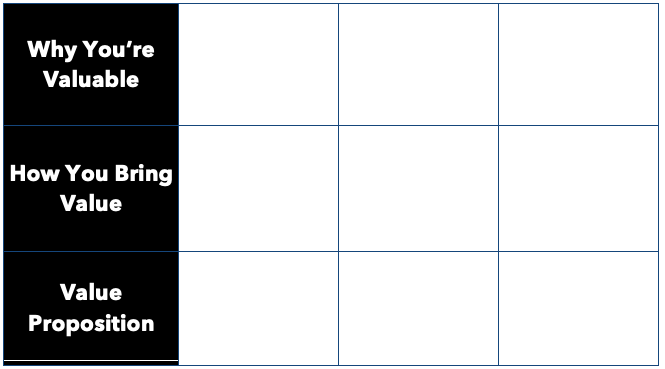How to Create Real Value Propositions
How to Create Real Value Propositions
“Value proposition” is typically one of the first marketing vocabulary words that the “fake it til you make it” professionals intertwine in their vocabulary. And look, I get it. It sounds cool and it’s easy to grasp the concept from the name alone. It was my first marketing vocabulary phrase and it felt damn good to say out loud. Consider me a huge fan of the value prop (and if you say it just like that, kids, you’ll look as cool as Joe Namath in 1965).
One of the rather annoying aspects of value props, however, is that every marketer interprets their structure and role differently.
Like the Positioning Statement, many take an internal approach with a formula like this one from Winer and Moore in their 1999 book, Marketing Management:
For (target customer) who (need statement), the (product/brand name) is a (product category) that (key benefit statement/compelling reason to buy). Unlike (primary competitor alternatives), (product/brand name) (primary differentiation statement).
To everyone who made it through that, congratulations. For the rest of the crowd, I agree, it’s way too boring and you would never use this in external communication. So let’s rule out this model.
Neil Rackham, the author of Spin Selling, has a value proposition formula that consists of four main parts: Capability – Impact – Proof – Cost.
Capability is what you do and how you do it.
Impact represents the benefits or differences your capability will make.
Proof is the evidence that substantiates your impact.
Cost is the cost (or risk) of your capability and impact.
Rackham’s approach is savvy but complicated. I think it’s a fun exercise to walk through at your next CMO Convention, but for small business owners, they’re going to get lost in an exercise that goes beyond their needs.
If we look Gino Wickman’s EOS model, the “value proposition” is stripped down. Businesses are to directed to simply list their “Three Uniques.” The approach is minimal, which is good, but it strips the concept of “value” away from the process.
Fortunately, the Purposeful Marketing Method threads the best concepts together once again.
With the simplicity of the EOS Model, the focus on value from Rackham’s formula, and the exact OPPOSITE communication approach as the Winer and Moore structure, here’s how the PMM produces Value Propositions.
First, the three rules of the VPs:
- If the opposite cannot be said about a competitor, it is not a true value proposition. For instance, “We have the best customer service” is not a value proposition because no company would ever say “We prioritize short-lived profits over customer service.” Every company thinks they have great customer service (well, maybe not Spirit Airlines). It’s an expectation to be customer-friendly. The value is in doing something different from the rest of your industry and owning your unique approach when dealing with customers.
- Every fruitful relationship in life must require each party to provide value to the other. If you want to enter a relationship with a customer, value must come from both sides. So when identifying your value propositions, don’t just outline what makes you valuable, but rather, how your value can be reciprocated to your customers.
- Lastly, the fine people who wrote 2007’s Value Merchant claim that “value proposition statements are internal documents, used by organizations as a blueprint to ensure that all the messages they communicate, inside and outside the organization, are consistent.” While I’m sure they’re good folks and their audience needs value propositions to stay on the inside, value propositions must ABSOLUTELY be written for your customers. If it sounds overly “market-y” or complicated, it’s not what we want. We need a 1 sentence message that says “this is what makes us valuable” and “here’s how you obtain value from it.” It’s so simple, even the executives at Spirit Airlines could figure it out.
Who’s ready to get some strong value propositions flowing? Alright, gather up the team and let’s get into it.
Take a look at the chart below. Pretty simple, right?

Start with just three reasons you find your company to be most valuable to prospects and customers. You’re just identifying them here. You will iron out the message in just a minute.
Brainstorm together. Rank the top five. Talk through it with the team, and settle on your top 3.
Now move down to Row 2 and identify how each of the “valuable assets” identified in Row 1 brings value to the customer.
Let’s use some examples…
If you’re an e-commerce store who’s valuable because of a lightning-fast checkout process, then “how you bring value” to your customers would be saving time and stress. If you’re a Thai restaurant that is the only place in town serving a rare dish, then you bring value with a unique tasting opportunity for your region/state/city. If you sell an open-sourced Project Management tool, you bring value with the integrations the tool can offer with calendars and other external applications.
You need to take the extra step to show customers you are there to solve their problems. Chances are, your business exists because there was something missing and you knew how to come in and save the day. Go back to the basics.
Turning Value into a Strong Marketing Message
Now we’re back to the tough part – turning our Value Propositions into strong communications for your website, sales collateral, and other marketing endeavors.
Going back to our Tagline exercise, let’s aim to explain the values concisely and be as clear as possible. Additionally, we will use our approach to the “how” from our positioning statement, making sure our language is as detailed as possible.
Let’s try knocking out some Value Props from the above examples:
The E-commerce Store:
Our 2-step checkout process saves an average of 58 seconds on every order.
The Thai Restaurant:
We are the only restaurant in region to serve Pak Ped Tod.
The Project Management Tool:
Our Open API connects with Salesforce, Hubspot, and over 1,000 other web applications.
Not bad, eh?
The Secret of the “Opposite“ Factor
Remember, an important part of this is creating value propositions where the opposite CAN’T be true for a competitor.
Using our examples above, e-commerce sites that place a higher value on security are not going to have as simple and easy of a checkout process. Restaurants that value providing common dishes to their patrons will not consider a rarity on their menu a unique factor to hang their hats on. Hosted solutions that have built proprietary tools within their Project Management software wouldn’t recommend wasting time integrating multiple apps.
See how that works?
Now since you’ve made it all the way down here, I’m going to go ahead and let you in on the reason this “opposite” approach is so vital: it supports your why.
You see, if the opposite of your value proposition can be true, then part of your value is that you have a distinct point of view. Look at our buddies running the e-commerce store: they believe in efficiency above all. Everything they do serves this belief. That’s why their checkout speed is so fast. That’s why their other props probably include free returns on all items and packages shipped to your doorstep that don’t need to be signed for. Efficiency rules all. In their case, it even rules security. If you follow that belief in your own life, you will shop at their store over competitors that may protect you better but possess a longer checkout process.
Because that’s who you are, and that’s why this brand resonates with you.
Who does your brand resonate to?
—-
Alright, it’s time to start spraying these value propositions across your marketing materials and start the conversation with “There’s three things we do really well. First…”
Let your customers know you’ve been in their shoes, and through these three aspects of your business, you can solve their problems.



